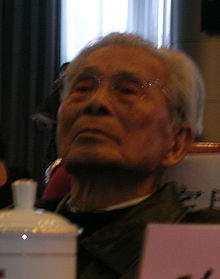- Wu Guanzhong
-
Wu Guanzhong
吴冠中
Nombre de nacimiento Wu Guanzhong Nacimiento 29 de agosto de 1919
Yixing, Jiangsu, China
ChinaFallecimiento 25 de junio de 2010 (90 años) Nacionalidad China Área Pintura Wu Guanzhong, en chino 吴冠中 (n. provincia de Jiangsu, 29 de agosto de 1919 - 25 de junio de 2010), fue, posiblemente, el pintor contemporáneo chino más reconocido.
Wu ha pintado diversos aspectos de China y gran parte de su arquitectura, plantas, animales, personas, así como muchos de sus paisajes y cursos de agua en un estilo inspirado en los pintores impresionistas de comienzos del siglo XX. También se ha destacado como escritor y crítico del arte chino contemporáneo.[1]
Contenido
Vida
Wu nació en Yixing, provincia de Jiangsu, en 1919. En 1935, Wu ingresó a estudiar ingeniería en la Escuela Industrial de Zhejiang (浙江 公立 工业 专门 学校, una escuela técnica de la Universidad de Zhejiang) en Hangzhou.[2]
En 1936 se trasladó a la Academia Nacional de Artes de Hangzhou, estudiando tanto la pintura china como la occidental bajo la dirección de Pan Tianshou (1897-1971) y Lin Fengmian (1900-1991). En 1942 se graduó de la Academia Nacional de Artes de Hangzhou.
En 1947 viajó a París para estudiar en la École nationale supérieure des beaux-arts con una beca del gobierno.
Wu presentó los aspectos del arte occidental a sus alumnos en la Academia Central de Arte en Beijing, donde enseñó desde 1950 a 1953.
Entre 1953 y 1964 enseñó en la Universidad Tsinghua, de Beijing, y luego en la Escuela Normal Collegede Bellas Artes de Beijing . En 2008, Wu donó 133 obras al Museo de Arte de Singapur (SAM). Esta donación constituye el mayor donación de Wu Guanzhong en un museo público.
Exposiciones
Wu Guangzhong ha realizado exposiciones individuales en las galerías de arte más importantes y museos de todo el mundo, incluyendo China, Hong Kong, Singapur, Tokio, Taipei, Corea, Inglaterra y los EE.UU.
Sus pinturas se han expuesto en el Museo Británico de Londres, en el Museo Metropolitano de Arte de Nueva York[3] y en el Hong Kong Museum of Art.
Referencias
- ↑ Michael Sullivan,Los artistas modernos de China: un diccionario biográfico, University of California Press, 2006, p175. ISBN 0-520-24449-4
- ↑ Baidu.com: Biografía de Wu Guanzhong
- ↑ Robert H. Ellsworth [1]
Enlaces externos
 Wikimedia Commons alberga contenido multimedia sobre Wu Guanzhong. Commons
Wikimedia Commons alberga contenido multimedia sobre Wu Guanzhong. Commons- [2] Galería de Pinturas de Wu Guanzhong
- [3] Wu Guanzhong en artnet
- [4] Galería en Baidu
- David Barbosa, [5] EnThe New York Times, 6 de octubre 2005.
Categorías:- Nacidos en 1919
- Fallecidos en 2010
- Pintores de China
- Pintores impresionistas
- Alumnos de la Universidad de Zhejiang
- Universidad de Tsinghua
Wikimedia foundation. 2010.
